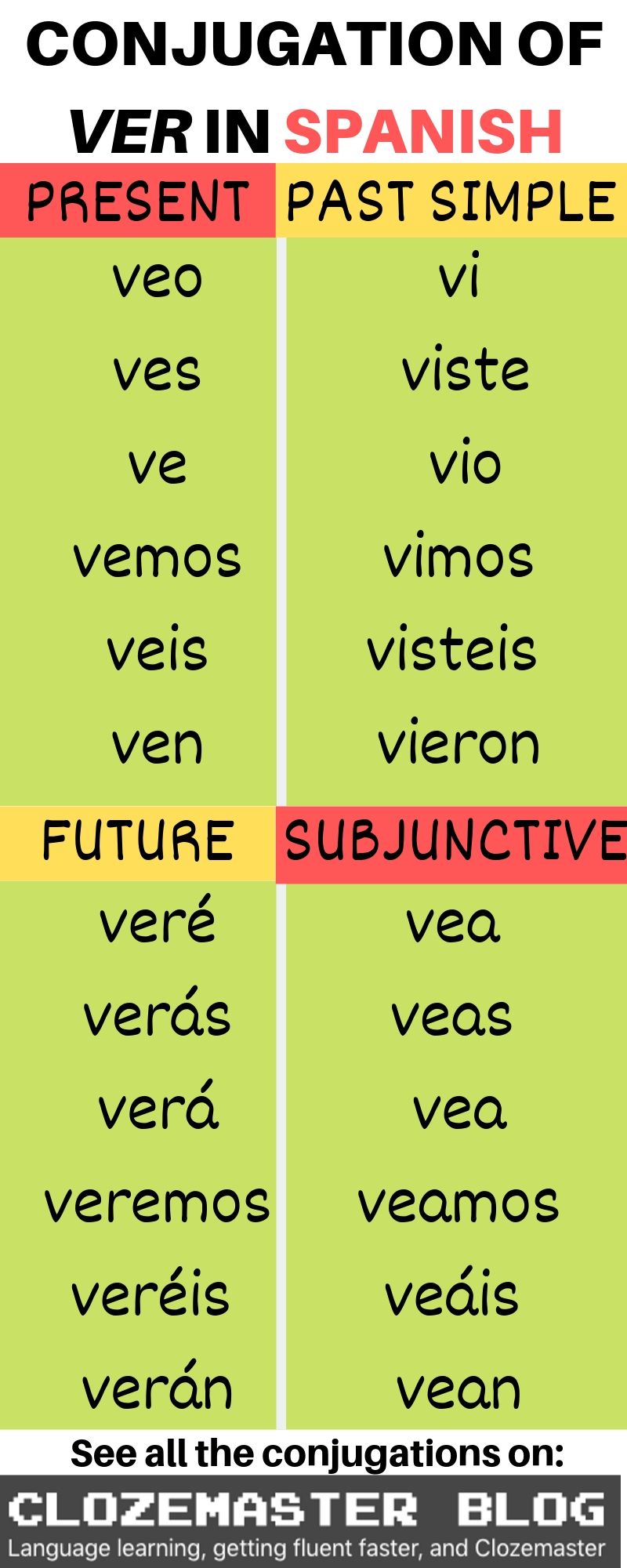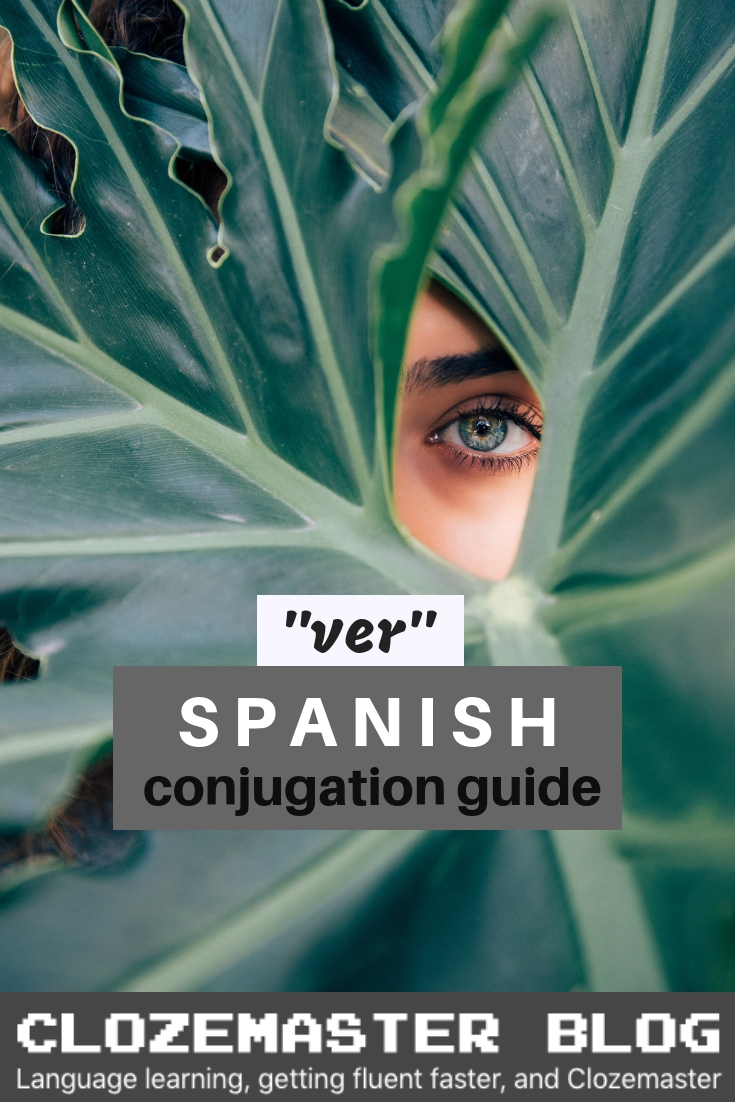
To see or not to see, that is the… oh, wait, that’s not it is it – never mind… Well, it might not have as famous a rep as “to be”, but “to see” is still a very important verb – yes, in Spanish, too! Today, we are going to look at this verb ver and see just how it works in Spanish, what forms it takes, and how it differs from the English equivalent.
Verbals of ver
To use ver in a sentence, you will either conjugate it, or use a verbal. Let’s start by seeing how the three verbals work with this verb.
Infinitive: ver (to see)
Example: Mi hermano no me quiere ver. | My brother doesn’t want to see me.
Gerund: viendo (seeing)
Example: El peque está viendo televisión. | The little one is watching TV.
See more on how to use the gerund in our estar conjugation guide.
Participle: visto (seen)
Example: Yo nunca había visto eso en toda mi vida. | I had never seen that in my whole life.
For an explanation on this structure, see our article on how to use haber.
Note: this is not the same word as vista, which is a noun meaning “view”.

Ver conjugation: basic forms
The most common ver conjugation forms are as follows:
| Subject | Present | Preterite | Future | Imperfect |
| yo | veo | vi | veré | veía |
| tú | ves | viste | verás | veías |
| él, ella, Usted | ve | vio | verá | veía |
| nosotros | vemos | vimos | veremos | veíamos |
| vosotros | veis | visteis | veréis | veíais |
| ellos, ellas, ustedes | ven | vieron | verán | veían |
Examples of ver conjugation in present tense
- Veo que tú no me quieres ayudar. | I see you don’t want to help me.
- Nos vemos todos los días. | We see each other every day.
- ¿Veis que así no se va a arreglar nada? | Do you see that this way nothing will be fixed?
The present tense of the verb ver is almost entirely regular. As long as you know the regular -er construction, you should have no trouble remembering how to conjugate ver in the present tense. The only different is the extra -e that appears in the conjugated forms. If you need a refresher on those regular forms, check out our comprehensive Spanish conjugation guide!
Examples of ver conjugation in past preterite tense
- Vi que él estaba con otra mujer. | I saw that he was with another woman.
- Maria Luisa vio que no iba a poder hacer a Juan Paolo cambiar de idea. | Maria Luisa saw that she wouldn’t be able to make Juan Pablo change his mind.
- Todos vieron que José ya no quería estar allí. | Everyone could see that Jose didn’t want to be there anymore.
The past preterite is probably the most irregular of all the conjugations of ver, so it is good to spend a bit more time on this one.
Examples of ver conjugation in future tense
- Voy a ser el jefe algún día, ya verás. | I’m going to be the boss one day, you’ll see.
- Ella no está arrepentida ahora, pero pronto verá que yo soy la persona para ella. | She isn’t regretful now, but soon she’ll see that I’m the person for her.
- Cuando lleguemos en la cima del monte, veremos el paisaje de toda la región. | When we get to the top of the hill, we will see the scenery of the whole region.
This is one part of the ver conjugation that is entirely regular – with no exceptions!
Examples of ver conjugation in past imperfect tense
- Cuanto más hablé con ella, más veía que negociar era imposible. | The more I talked to her, the more I saw that it was impossible to negotiate.
- Elisa era una mujer muy agradable, pero veía los negocios como si fueran un juego, y eso no era aceptable. | Elisa was a very nice woman, but she saw business as a game, and that wasn’t acceptable.
- En esa época, eramos jóvenes y libres, y se nos veían como niños. | At that time, we were young and free, and we were seen as children.
Ver conjugation: Advanced forms
| Subject | Present Subjunctive (that you) see | Imperfect Subjunctive (if I) saw… |
Conditional (I) would see |
| yo | vea | viera | vería |
| tú | veas | vieras | verías |
| él, ella, Usted | vea | viera | vería |
| nosotros | veamos | viéramos | veríamos |
| vosotros | veáis | vierais | veríáis |
| ellos, ellas, ustedes | vean | vieran | verían |
Examples of ver conjugation in present subjunctive
- Yo quiero que tú veas lo que hiciste. | I want you to see what you did.
- Pinté el cuadro así para que se vea bien los colores. | I painted the picture like this so that you can see the colours well.
- Cuando mis padres vean el desorden aquí, te van a castigar. | When my parents see the mess here, they are going to punish you.
Examples of ver conjugation in imperfect subjunctive
- Si tú vieras lo que yo vi, tú también estarías con miedo. | If you saw what I saw, you’d be scared, too.
- El profesor quería que nosotros vieramos la película El Hijo. | The teacher wanted us to see the movie The Son.
- Me gustó que ustedes vieran lo importante que es este evento. | I liked that you all saw how important this event was.
Examples of ver conjugation in conditional mood
- Si yo pudiera, vería a mi novia todos los días. | If I could, I would see my girlfriend every day.
- Si María supiera lo que he hecho, seguro que me vería. | If Maria knew what I have done, surely she would see me differently.
- No sabía que veríamos toda la información ya. | I didn’t know that we would see all the information now.
Some quick notes on the usage of ver
To see / to be able to see
In many cases where we would use the word can in English, the equivalent is omitted in Spanish. This is generally when the ability is inherent, such as the five senses. So, if you are at the back of the crowd at a concert in Spanish, and you can’t see the stage, it’s quicker, more efficient, and much more common to say, “no veo, no veo.”
To see vs. to watch vs. to view
The verb ver means see, view and watch, all at the same time, so its application is much wider in Spanish than any of the English translations. Be careful with mirar though. Some learners confuse these two words and use mirar when it should be ver. A common mistake is using mirar for watching TV, movies, etc., when in fact, it should always be ver for those cases.
Hopefully this article has cleared up the ver conjugation in Spanish and uses of the verb “ver”. Remember, ver is irregular so what is true for this verb is not necessarily true for other verbs. If you want to see how regular verbs are conjugated, or just want to brush up on your knowledge of the different tenses, make sure you check out our overview of tenses in Spanish, which has all the info you need.
Don’t forget to use Clozemaster to practise your Spanish sentences and test your knowledge of Spanish grammar!
Challenge yourself with Clozemaster
Test your skills and see what you’ve learned from this article by playing a selection of sentences with conjugated forms of the Spanish verb ver:
Sign up here to save your progress and start getting fluent with thousands of Spanish sentences at Clozemaster.
Clozemaster has been designed to help you learn the language in context by filling in the gaps in authentic sentences. With features such as Grammar Challenges, Cloze-Listening, and Cloze-Reading, the app will let you emphasize all the competencies necessary to become fluent in Spanish.
Take your Spanish to the next level. Click here to start practicing with real Spanish sentences!


